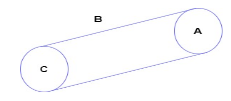
A hollow cylinder has a charge q coulomb within it. If $ \phi $ is the electric flux in units of voltmeter associated with the curved surface B, the flux linked with the plane surface A in units of voltmeter will be
(A) $ \dfrac{1}{2}\left( \dfrac{q}{{{\varepsilon }_{0}}}-\phi \right) $
(B) $ \dfrac{q}{2{{\varepsilon }_{0}}} $
(C) $ \dfrac{\phi }{3} $
(D) $ \dfrac{q}{{{\varepsilon }_{0}}}-\phi $
Answer
542.7k+ views
Hint: Apply Gauss law to calculate the flux associated with plane surface A. According to Gauss law: The total flux linked with a closed surface is $ \dfrac{1}{{{\varepsilon }_{0}}} $ times the charge enclosed by the closed surface. The Gauss Law formula is expressed by :
$ \phi =\dfrac{Q}{{{\varepsilon }_{0}}} $
Where Q is total charge within the surface, $ {{\varepsilon }_{0}} $ is electrical constant.
Complete step by step solution:
We have given, A hollow cylinder having charge = q coulomb
The electrical flux associated with surface B is $ {{\phi }_{B}}=\phi $
The electrical flux associated with surface A and C is $ {{\phi }_{A}}$ and ${{\phi }_{C}} $ respectively.

Since surface A and C have the same area of cross section.
So, $ {{\phi }_{A}}={{\phi }_{C}} $
Now, apply Gauss Law:
According to which the net electric flux through any closed surface is equal to the net charge inside the surface divided by $ {{\varepsilon }_{0}} $ .
$ {{\phi }_{TOTAL}}={{\phi }_{A}}+{{\phi }_{B}}+{{\phi }_{C}} $ --------(1)
Since, $ {{\phi }_{A}}={{\phi }_{C}} $ , $ {{\phi }_{B}}=\phi $
From eq. (1) $ {{\phi }_{TOTAL}}={{\phi }_{A}}+{{\phi }_{{}}}+{{\phi }_{A}} $
$ $ $ {{\phi }_{TOTAL}}=2{{\phi }_{A}}+\phi $ --------(2)
By Gauss Law Formula
$ {{\phi }_{TOTAL}}=\dfrac{q}{{{\varepsilon }_{0}}} $
Using value of eq. (2) in above eq.,
$ 2{{\phi }_{A}}+\phi =\dfrac{q}{{{\varepsilon }_{0}}} $
$ 2{{\phi }_{A}}=\dfrac{q}{{{\varepsilon }_{0}}}-\phi $
$ {{\phi }_{A}}=\dfrac{1}{2}\left( \dfrac{q}{{{\varepsilon }_{0}}}-\phi \right) $ This is the required result.
Hence, option A is correct.
Note:
Gauss Law holds good for any closed surface regardless of its shape and size.
Gauss law is used commonly for symmetric charge distribution.
By Gauss theorem, we can calculate the number of electric lines of force that radiate outwards from one coulomb of positive charge in vacuum.
$ \phi =\dfrac{q}{{{\varepsilon }_{0}}},for\text{ }q=1C,\text{ }then\text{ }\phi =\dfrac{1}{8.85\times {{10}^{-12}}}=1.13\times {{10}^{11}} $
$ \phi =\dfrac{Q}{{{\varepsilon }_{0}}} $
Where Q is total charge within the surface, $ {{\varepsilon }_{0}} $ is electrical constant.
Complete step by step solution:
We have given, A hollow cylinder having charge = q coulomb
The electrical flux associated with surface B is $ {{\phi }_{B}}=\phi $
The electrical flux associated with surface A and C is $ {{\phi }_{A}}$ and ${{\phi }_{C}} $ respectively.

Since surface A and C have the same area of cross section.
So, $ {{\phi }_{A}}={{\phi }_{C}} $
Now, apply Gauss Law:
According to which the net electric flux through any closed surface is equal to the net charge inside the surface divided by $ {{\varepsilon }_{0}} $ .
$ {{\phi }_{TOTAL}}={{\phi }_{A}}+{{\phi }_{B}}+{{\phi }_{C}} $ --------(1)
Since, $ {{\phi }_{A}}={{\phi }_{C}} $ , $ {{\phi }_{B}}=\phi $
From eq. (1) $ {{\phi }_{TOTAL}}={{\phi }_{A}}+{{\phi }_{{}}}+{{\phi }_{A}} $
$ $ $ {{\phi }_{TOTAL}}=2{{\phi }_{A}}+\phi $ --------(2)
By Gauss Law Formula
$ {{\phi }_{TOTAL}}=\dfrac{q}{{{\varepsilon }_{0}}} $
Using value of eq. (2) in above eq.,
$ 2{{\phi }_{A}}+\phi =\dfrac{q}{{{\varepsilon }_{0}}} $
$ 2{{\phi }_{A}}=\dfrac{q}{{{\varepsilon }_{0}}}-\phi $
$ {{\phi }_{A}}=\dfrac{1}{2}\left( \dfrac{q}{{{\varepsilon }_{0}}}-\phi \right) $ This is the required result.
Hence, option A is correct.
Note:
Gauss Law holds good for any closed surface regardless of its shape and size.
Gauss law is used commonly for symmetric charge distribution.
By Gauss theorem, we can calculate the number of electric lines of force that radiate outwards from one coulomb of positive charge in vacuum.
$ \phi =\dfrac{q}{{{\varepsilon }_{0}}},for\text{ }q=1C,\text{ }then\text{ }\phi =\dfrac{1}{8.85\times {{10}^{-12}}}=1.13\times {{10}^{11}} $
Recently Updated Pages
A man running at a speed 5 ms is viewed in the side class 12 physics CBSE

State and explain Hardy Weinbergs Principle class 12 biology CBSE

Which of the following statements is wrong a Amnion class 12 biology CBSE

Two Planoconcave lenses 1 and 2 of glass of refractive class 12 physics CBSE

The compound 2 methyl 2 butene on reaction with NaIO4 class 12 chemistry CBSE

Bacterial cell wall is made up of A Cellulose B Hemicellulose class 12 biology CBSE

Trending doubts
What are the major means of transport Explain each class 12 social science CBSE

Which are the Top 10 Largest Countries of the World?

Draw a labelled sketch of the human eye class 12 physics CBSE

State the principle of an ac generator and explain class 12 physics CBSE

Sketch the electric field lines in case of an electric class 12 physics CBSE

Give 10 examples of unisexual and bisexual flowers




